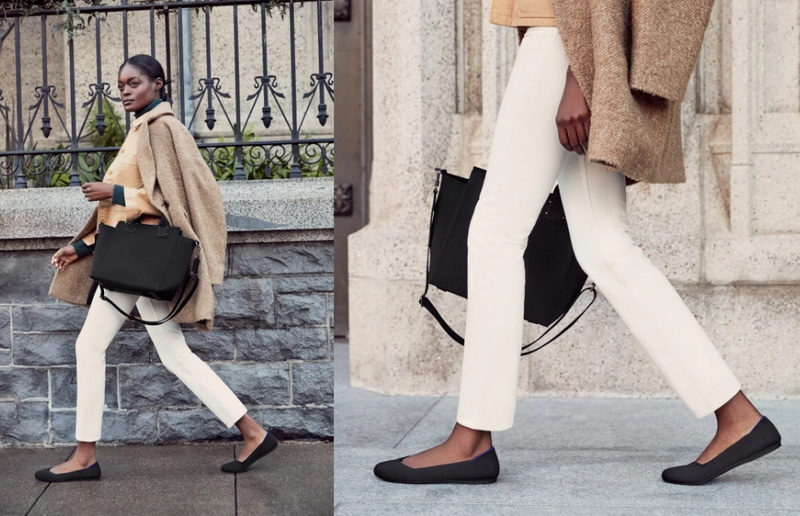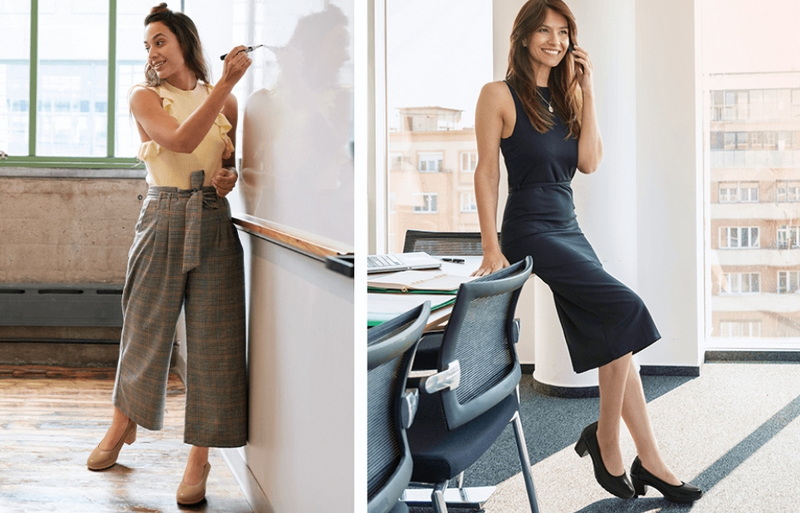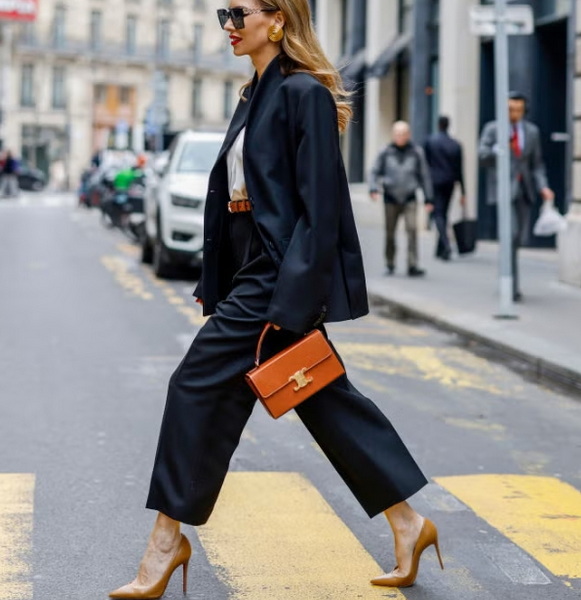Content Menu
● What Are Business Casual Shoes for Women?
● Essential Types of Business Casual Shoes for Women
>> Loafers
>> Classic Flats
>> Low Heels and Pumps
>> Ankle Boots
>> Oxfords and Derbies
>> Sneakers
>> Mules and Slingbacks
● How to Choose the Right Business Casual Shoes
>> Prioritize Comfort and Fit
>> Consider Material and Quality
>> Match the Season
>> Reflect Your Personal Style
>> Maintain a Clean and Polished Appearance
● Styling Business Casual Shoes
>> With Trousers
>> With Skirts and Dresses
>> With Jeans
>> With Leggings
● Dos and Don'ts of Business Casual Footwear
>> Dos:
>> Don'ts:
● Business Casual Shoes for All Body Types
>> For Petite Women
>> For Plus-Size Women
● Conclusion
● Frequently Asked Questions (FAQ)
>> 1. What qualifies as a business casual shoe for women?
>> 2. Can I wear sneakers as part of a business casual outfit?
>> 3. Are open-toe shoes acceptable in a business casual setting?
>> 4. How many pairs of business casual shoes should I own?
>> 5. How do I keep my business casual shoes looking professional?
● Citations:
In today's ever-evolving professional landscape, the concept of business casual has become the standard in many workplaces. At the heart of this dress code lies a crucial element: footwear. For women, business casual shoes are not just about style—they are about comfort, versatility, and making a confident impression. This comprehensive guide explores everything you need to know about business casual shoes for women, from the best styles to how to choose, style, and care for them. Whether you're building a new work wardrobe or seeking to refresh your current collection, this article will help you step confidently into any office environment.

What Are Business Casual Shoes for Women?
Business casual shoes for women are designed to bridge the gap between formal and casual, offering a polished look without the strict formality of traditional dress shoes. These shoes are appropriate for most professional settings and are versatile enough to pair with a variety of outfits, including tailored pants, skirts, and dresses. The ideal business casual shoe is comfortable for all-day wear, made from quality materials, and maintains a clean, professional appearance[1][5].
Essential Types of Business Casual Shoes for Women
Loafers
Loafers are a staple in any business casual wardrobe. Their slip-on design, available in materials like leather and suede, combines comfort with style. Loafers can be paired with pants, skirts, or dresses and come in various colors and accents, such as tassels or metal hardware, allowing for a touch of personality while maintaining professionalism[1][5][6].
Classic Flats
Flats are the unsung heroes of office footwear, offering both comfort and versatility. Neutral colors like black, beige, or tan maximize adaptability, while quality materials like leather or suede ensure durability. Ballet flats, pointed-toe flats, and Mary Janes are all excellent choices for a business casual environment[5][6].
Low Heels and Pumps
For those who want a bit of elevation without sacrificing comfort, low heels and pumps are ideal. Choose moderate heel heights for all-day wear and opt for classic colors such as black, nude, or navy. Kitten heels and block heels are particularly popular for their blend of style and practicality[5][7][8].
Ankle Boots
Ankle boots are a versatile option, especially in cooler seasons. Sleek leather or suede boots with a modest heel can be paired with dresses, skirts, or tailored pants for a refined business casual look. Chelsea boots and Chukka boots are also excellent choices for their modern appeal[5][7].
Oxfords and Derbies
Oxfords and Derbies offer a sophisticated alternative to traditional women's footwear. Their structured design and classic look make them suitable for both pants and skirts, adding a touch of elegance to your business casual attire[1][5].
Sneakers
Contrary to popular belief, sneakers can be appropriate for business casual settings when chosen carefully. Opt for minimalist designs in neutral colors, avoiding athletic or flashy styles. These sneakers can be paired with tailored trousers, midi skirts, or dresses for a modern, comfortable look[1][5].
Mules and Slingbacks
Mules and slingbacks are stylish, easy-to-wear options for warmer months. Their open-back design provides comfort, while their sleek appearance ensures they remain office-appropriate. Choose classic colors and subtle embellishments for a polished finish[8][6].
How to Choose the Right Business Casual Shoes
Prioritize Comfort and Fit
Comfort is paramount when selecting business casual shoes. Look for cushioned insoles, supportive arches, and breathable materials to ensure you can wear them all day without discomfort. Brands focusing on ergonomic design often offer the best balance between style and support[7].
Consider Material and Quality
Invest in shoes made from high-quality materials such as genuine leather or suede. Not only do these materials last longer, but they also maintain their appearance better over time. Quality construction ensures your shoes remain comfortable and stylish through repeated wear[5][7].
Match the Season
- Winter: Opt for darker colors and thicker materials like leather or suede. Ankle boots and loafers are ideal.
- Spring/Summer: Choose lighter colors and breathable fabrics. Flats, mules, and slingbacks work well.
- Autumn: Rich hues and transitional styles like loafers and ankle boots are perfect for the season[5][8].
Reflect Your Personal Style
Business casual doesn't mean sacrificing individuality. Experiment with different textures, subtle patterns, or statement accessories, but always ensure your choices align with your workplace culture and dress code[5].
Maintain a Clean and Polished Appearance
Your shoes should always be clean and in good repair. Scuffed, worn, or dirty footwear can detract from your professional image. Regular maintenance, such as polishing leather and protecting suede, is essential[1][5].

Styling Business Casual Shoes
With Trousers
Pair loafers, oxfords, or low heels with tailored trousers for a classic business casual look. Ankle boots also work well, especially in colder months.
With Skirts and Dresses
Flats, pumps, and ankle boots complement knee-length or midi skirts and dresses. For a modern twist, try pairing minimalist sneakers with a structured dress.
With Jeans
Dark-wash, well-fitted jeans can be styled with loafers, flats, or ankle boots for a smart, approachable outfit. Add a blazer or tailored coat for extra polish.
With Leggings
On more relaxed business casual days, pair leggings with knit flats, sneakers, or mules. Balance the look with a long blouse or tunic and a blazer.
Dos and Don'ts of Business Casual Footwear
Dos:
- Opt for classic styles like loafers, ankle boots, oxfords, and sleek sneakers[1][5].
- Prioritize comfort and fit for all-day wear.
- Maintain a clean and polished appearance.
- Invest in quality, versatile shoes that complement various outfits.
- Express your style within professional boundaries[5].
Don'ts:
- Avoid overly casual shoes like flip-flops or athletic sneakers unless explicitly permitted by your workplace.
- Steer clear of excessively high heels or shoes that hinder mobility.
- Skip shoes with loud patterns or excessive embellishments for a professional setting.
- Don't compromise on comfort or overlook the importance of workplace culture and dress code[5].
Business Casual Shoes for All Body Types
For Petite Women
- Choose pointed-toe shoes to elongate the legs.
- Nude-colored shoes can create a leg-lengthening effect[5].
For Plus-Size Women
- Prioritize comfort with cushioned insoles and stable heels.
- Experiment with bold colors or statement accessories to express personal style[5].
Conclusion
Choosing the right business casual shoes is an art that balances style, comfort, and workplace appropriateness. From classic loafers and versatile flats to chic boots and modern sneakers, today's business casual footwear offers endless possibilities for expressing professionalism and individuality. By prioritizing comfort, investing in quality, and maintaining a polished appearance, you can build a shoe collection that supports you through every workday challenge. Step confidently into your business casual journey, knowing your footwear is as ready as you are.

Frequently Asked Questions (FAQ)
1. What qualifies as a business casual shoe for women?
Business casual shoes are those that offer a polished, professional appearance without being overly formal. This includes loafers, flats, low heels, ankle boots, oxfords, and minimalist sneakers. The key is to ensure the shoe is clean, well-maintained, and complements your outfit[1][5].
2. Can I wear sneakers as part of a business casual outfit?
Yes, minimalist sneakers in neutral colors can be worn as part of a business casual outfit. Avoid athletic or flashy designs, and pair them with tailored pants, skirts, or dresses for a modern, professional look[1][5].
3. Are open-toe shoes acceptable in a business casual setting?
Open-toe shoes can be acceptable in some workplaces, especially during warmer months. However, closed-toe styles are generally safer and more professional. Always consider your company's dress code before opting for open-toe shoes[5].
4. How many pairs of business casual shoes should I own?
Most women benefit from owning at least three pairs: a pair of loafers or flats, a pair of pumps or low heels, and a pair of boots or sneakers. This provides variety and accommodates seasonal changes[5].
5. How do I keep my business casual shoes looking professional?
Regularly clean and polish leather shoes, use protective sprays for suede, and store shoes properly. Rotate your shoes to avoid excessive wear, and invest in quality pairs for durability and lasting style[1][5].
Citations:
[1] https://www.sumissura.com/en/blog/business-casual-shoes-for-women
[2] https://www.pinterest.com/pin/97953360629550351/
[3] https://www.nordstrom.com/browse/women/occasion/work/shoes
[4] https://www.letsgetyou.com/blog/womens-business-casual-shoes-kt4st
[5] https://www.staedterstyle.com/business-casual-shoes-for-women/
[6] https://www.zappos.com/c/womens-casual-shoe-guide
[7] https://www.vionicshoes.com/women/wear-to-work.html
[8] https://www.aldoshoes.com/ca/en/women/collections/workwear
[9] https://www.pinterest.com/ideas/women's-business-casual-shoes/943959633753/
[10] https://cdnimg.dreampairs.com/dreampairshoes/image/article/20220830_88/sneakers-blazer-0923-edit.jpg?sa=X&ved=2ahUKEwj198DTodyMAxVID7kGHTmqILAQ_B16BAgBEAI

















